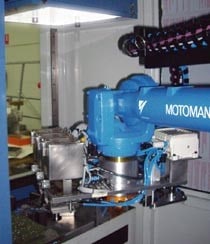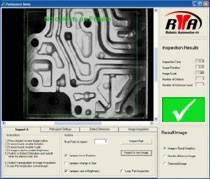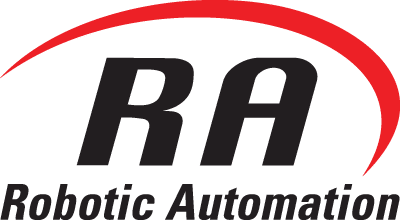Robotic Vision Assembly & Testing
CLIENT : Automotive parts company
PROBLEM : Assembling the multi-layered valve body of automatic transmission systems – 4 and 6 speed models. The client’s staff had to perform this repetitive and monotonous task while maintaining full concentration – there is 0% margin for error but many points in the process for error to occur. Worse still, it is very easy for errors to be overlooked.
The valve body is the control centre of the transmission. It uses a system of hydraulic fluid directed over a baffle plate via a layered network of pathways, valves, check balls and servo pistons. This layered network is sandwiched with gaskets before being screwed together.

During assembly, the operator is required to position a total of up to 6 springs and 7 check-balls of varying size at points in the maze-like pathways on each layer of the valve body. If just one of these is incorrectly placed, the final transmission unit will fail during testing and need to be disassembled – a wasteful and time-consuming exercise that cannot be afforded, particularly under the “lean manufacturing” methodology commonly required by the large automotive companies. Operators would also need to check that all other pathways were clear, that the springs operated freely and that each part was free of metal casting burrs. Working up to three shifts per day, six operators could be called upon to perform this repetitive yet exacting assembly procedure, with all the inherent potential for errors and repetitive strain injury.
SOLUTION : With this twin station solution, a single operator outside the cell can load the gaskets and baffle plates on one station while, inside the cell, the robot is completing assembly at the other station. The operator and robot then swap stations, with the operator removing a finished unit before loading new parts again. Production is continuous.

Beginning the automated process, the cell’s integrated vision system checks the position of the loaded parts and identifies any burrs, blockages or deformations formed during the casting of the metal parts. The Motoman HP50 robot now begins positioning springs and three sizes/colours of check-balls from its on-board magazines/dispensers into precise points on 2 baffle plates. The robot then retreats for a second to allow the vision system to confirm the balls & springs have all remained in place and no other material is blocking the pathways. The robot next checks that all 6 springs are performing freely to the correct specification by use of a position transducer on the gripper. The robot’s grippers are then used to position gaskets on the baffle plate which will create a watertight seal to withstand the pressurised hydraulic fluid when the unit is finally installed.
Lastly, the robot engages its tool-change interface to connect to the jig holding the top layer baffle plate. The robot lifts this whole jig, with set of plate, check-balls and gaskets in situ, before flipping and positioning atop the first set and then engaging the jig’s on-board screw drivers to lock the unit into final assembly. The finished unit is then ready to be unloaded while the robot immediately starts assembly of the next unit.
APPLICATION IN ACTION :
EQUIPMENT :
- MOTOMAN HP50 robot and NX100 controller
- RA designed end-of-arm tooling with multiple dispensers & magazines, pneumatic grippers & automatic tool-change interface
- RA designed lightbox/camera unit. Image recognition software
- RA designed jigging with screw driving system
- RA designed twin-station work cell with safety features: automatic screens, interlocks
BENEFITS :
- Minimised failure rate in the final unit
- Labour saved in disassembly and reassembly after failure
- Increased staff safety and reduced repetitive strains, injuries, lost production time, potential claims and compensation
- Shorter assembly time on each valve body
- Greater productivity
- Saved labour & associated costs x 4
- Less break time & down time
- Increased reliability and continuity of “lean” production
- Increased competitiveness by reducing overall costs
